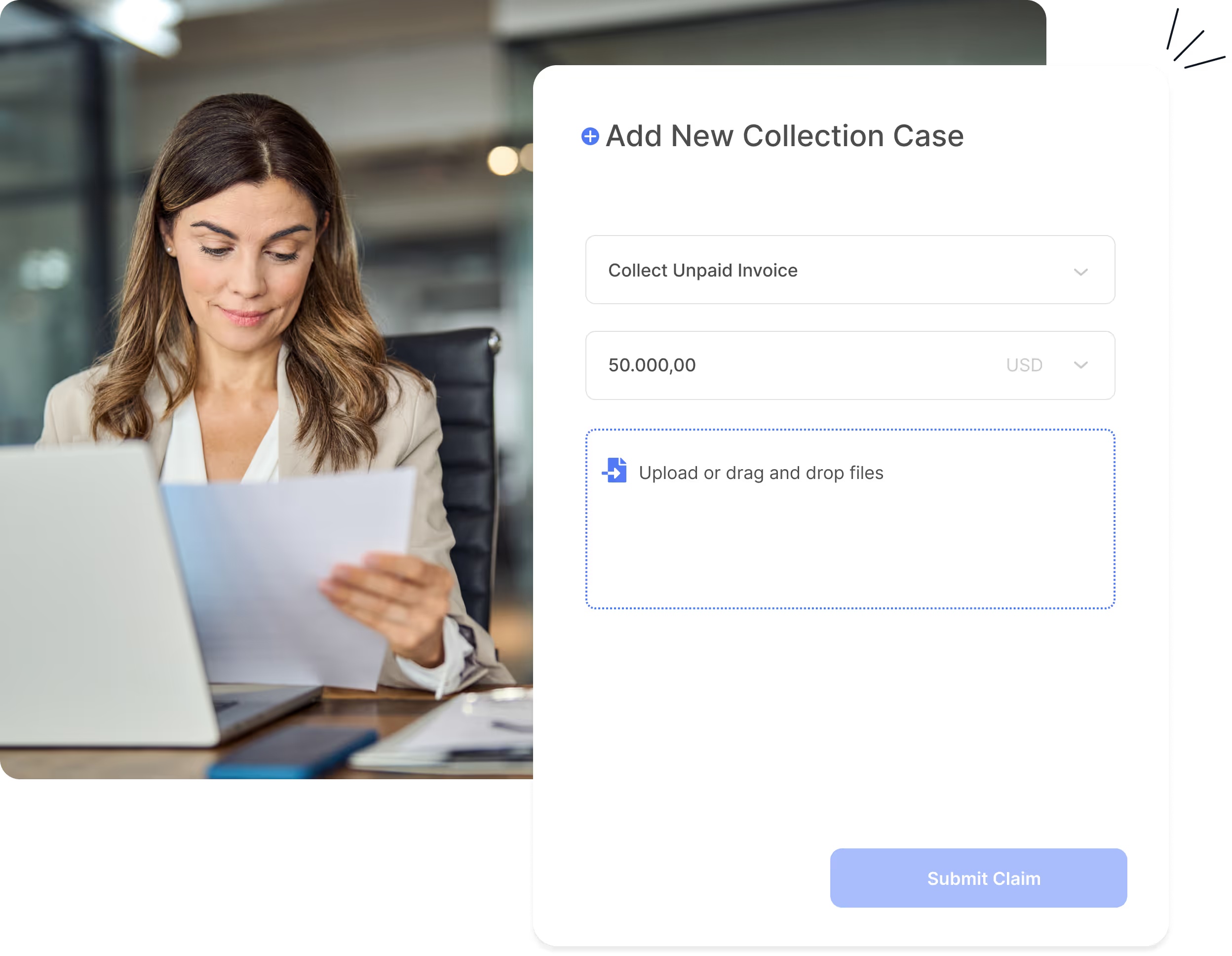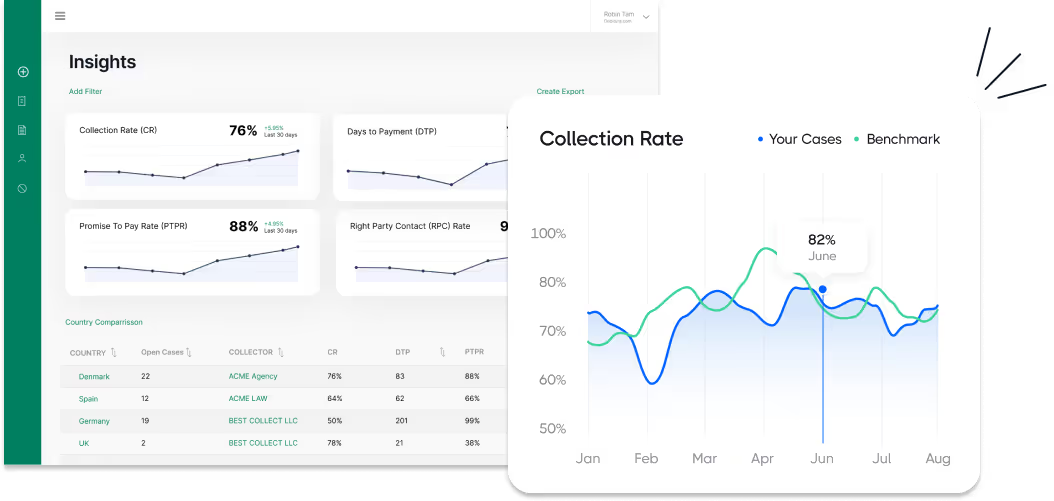Top-Rated Debt Collection Agency in Nepal
Your trusted debt collection agency in Nepal, delivering swift claim recovery with no upfront cost. Check our guide for local debt collection insights and strategies.






The ultimate guide about debt collection in Nepal
Why you can trust this guide
At Debitura, we uphold the highest standards of impartiality and precision to bring you comprehensive guides on international debt collection. Our editorial team boasts over a decade of specialized experience in this domain.
Questions or feedback? Email us at contact@debitura.com — we update this guide based on your input.
Debitura By the Numbers:
- 10+ years focused on international debt collection
- 100+ local attorneys in our partner network
- $100M+ recovered for clients in the last 18 months
- 4.97/5 average rating from 600+ client reviews
Expert-led, locally validated
Written by Robin Tam (16 years in global B2B debt recovery). Every page is reviewed by top local attorneys to ensure legal accuracy and practical steps you can use.
Contributing local experts:
Last updated:
Tackling debt collection in Nepal may seem overwhelming, but with Debitura, it doesn't have to be. Combining local expertise and global knowledge, this guide transforms the daunting process into an accessible path towards effective debt recovery.
Unravelling the Roles in Nepal's Debt Recovery Scene
To navigate the complex network of debt recovery processes in Nepal, it is vital to comprehend the vital roles and responsibilities of the key players ranging from debt collection agencies, bailiffs to debt collection attorneys. Each player orchestrates a unique part in recovering debts within Nepal's strict legal boundaries.
Debt Collection Agencies in Nepal: A Comprehensive Role
In Nepal's financial landscape, debt collection agencies like Debitura play a crucial role in bridging the gap between creditors and debtors. These agencies embark on the path of debt recovery through a blend of negotiation, diplomacy, and adherence to the legal framework provided by the Muluki Civil Code, 2074. Focused on the initial negotiation phase, they employ various communication techniques, including personalized letters, strategic phone calls, and targeted email campaigns, to foster voluntary settlements. Their operations, characterized by a deep respect for local customs and a commitment to maintaining business relations, pivot on the principle of amicable collection. This involves a clear understanding and negotiation strategy that respects the debtor's circumstances while effectively recovering the owed amount. The engagement of a debt collection agency is typically advised when internal recovery efforts cease to be productive, marking a strategic move towards leveraging professional expertise in navigating the intricate landscape of debt recovery in Nepal. It's worth noting, however, that while these agencies excel in extrajudicial recovery, they operate within a framework of ethical and legal constraints, with their powers limited to non-judicial actions. This distinct positioning makes them indispensable for creditors aiming for swift and effective resolution without immediate legal contention, yet they must hand over the baton to legal proceedings when debts remain unsettled.
Lawyers in Nepal
In Nepal, lawyers become indispensable particularly in complex debt collection cases that require judicial intervention. Their expertise is paramount in navigating the intricacies of legal proceedings, drafting and filing of legal documents, and representing the creditor in court. Lawyers step into the debt recovery process when a dispute necessitates a legal resolution or when the amount in question exceeds certain thresholds that require formal litigation. Their deep understanding of the legal landscape and specific regulations regarding debt recovery practices makes them invaluable for managing the judicial collection phase and ensuring that the creditor's rights are effectively upheld.
The Role of Bailiffs in Nepal
In Nepal, bailiffs play an essential and potent role in the sphere of debt recovery, acting under the judicial system's authority to enforce court judgments. These legal officers are primarily involved when amicable recovery efforts fail, and a creditor obtains a judgment against a debtor. Their tasks include executing asset seizures, facilitating evictions, and serving legal documents. Before a bailiff can be involved, a court order is a prerequisite, ensuring their actions are grounded in legal authority and aim to uphold the creditor's rights as decreed by the court.
Bailiffs' interventions in Nepal are characterized by actions such as entering a debtor's property to seize goods or assets, all performed within the strict confines of the law. This regulatory framework guarantees a fair balance, ensuring that creditors can recover debts effectively without infringing on the fundamental rights of debtors. The involvement of a bailiff marks a critical point in the debt collection process, underscoring the transition from voluntary compliance to enforced recovery based on judicial directives.
Navigating Nepalese Debt Collection Laws
Understanding the intricate legalities of debt collection in Nepal is crucial for effective recovery. Complying with these laws not only streamlines the process but also fosters fairness, laying the foundation for trust and integrity in all business undertakings.
The Regulatory Environment and Civil Court System in Nepal
The civil court system in Nepal is a structured hierarchy designed to manage legal disputes and enforce laws effectively, reflecting the country's commitment to justice.
- District Courts: At the base of the hierarchy are the District Courts, functioning as the primary courts for most civil litigation including debt recovery. These courts handle initial hearings and decisions on a broad range of civil matters.
- High Courts: Above the District Courts stand the High Courts (formerly known as Appellate Courts). Serving both as appellate courts for District Court decisions and as courts of first instance for more significant cases, High Courts play a vital role in Nepal's legal fabric.
- Supreme Court: At the pinnacle of the legal hierarchy is the Supreme Court of Nepal. This court holds ultimate appellate authority and the power to review, and if necessary, overturn decisions made by lower courts. It ensures uniformity in the legal system and interprets the constitutionality of laws.
The civil court system in Nepal, structured into District Courts, High Courts, and the Supreme Court, enables comprehensive judicial oversight and the efficient resolution of legal matters, ensuring justice is both accessible and fair across the country.
Key Legislation Impacting Debt Collection in Nepal
In the realm of financial transactions, Nepal operates under a set of comprehensive legal frameworks, ensuring a systematic approach to debt collection.
- Muluki Civil Code, 2074: Governs various aspects of transactions, loans, and debt collection, emphasizing on proper documentation and fair interest rates.
- Data Protection Regulation: Although not explicitly detailed in the provided data, it's inferred that Nepal has regulations to protect consumer data during the debt collection process.
- Insolvency Act: Dictates the procedures for bankruptcy and insolvency, crucial for cases where creditors seek recovery from financially distressed entities.
These laws ensure that all parties in debt transactions are treated fairly, with an emphasis on documentation, reasonable interest rates, and consumer protection. Legal proceedings, including the possibility of insolvency, are structured to provide a balanced approach towards both creditors and debtors, making the debt collection framework in Nepal both comprehensive and considerate.
Consumer Protection from Unfair Collection Practices in Nepal
In Nepal, consumer protection in debt collection is carefully managed through several legal provisions to ensure fairness and respect for borrowers' rights.
- The Muluki Civil Code, 2074 prohibits the collection of compound interest, mandating refunds if collected, safeguarding consumers against excessive financial charges.
- According to the same code, creditors can charge up to ten percent interest per annum as agreed in the deed, thus preventing unjust interest rates.
- Transactions must be documented in a deed including all relevant details such as parties involved, transaction reason, and repayment terms, which contributes to transparency and accountability.
- There is a clear emphasis on proper documentation for the repayment of principal and interest, ensuring consumers are not unfairly charged or penalized due to lack of evidence or poor record keeping.
- Section 491 of the Muluki Civil Code specifies that goods borrowed for a specific purpose must be returned in the same kind, quantity, and quality, protecting borrowers from unjust demands.
By codifying these protections, Nepal aims to balance the scales between creditors and consumers, leading to fairer debt recovery practices while maintaining the integrity of financial transactions.
Amicable Debt Collection in Nepal
In Nepal, resolving debts outside of court, known as amicable collection, provides a less intrusive and swifter solution. This introduction discusses the machinations of pre-legal debt recovery, offers tactics for successful execution, and underscores the benefits of assigning this task to a debt collection agency.
- Amicable Resolution Priority: Emphasizes negotiation between creditors and debtors to maintain business relations.
- International Agencies Involvement: Facilitated by specialists in amicable debt recovery, operating on a commission-based model.
- Lack of Comprehensive Legal Framework: Navigating a landscape without specific debt recovery laws, requiring careful engagement.
- Muluki Civil Code Provisions: Provides legal grounding, including interest rate regulations and recovery procedures.
- Statute of Limitations: Specifics vary, but some debts, particularly involving property rights violations, have no expiration.
- Interest and Collection Fees: Regulations allow for certain fees and interest, with restrictions in place for compliance.
- Business Relationships Preservation: Amicable processes prioritize long-term connections over immediate debt recovery.
- Specialized Courts Role: Potentially involved in judicial recovery if amicable efforts fail, under a hierarchical system.
- Consumer Protection: Regulations ensure fair treatment and protect against abusive debt recovery practices.
- Transition to Judicial Recovery: A strategic decision made after exhausting amicable avenues, requiring deep legal understanding.
Navigating Amicable Debt Collection in Nepal
In Nepal, amicable debt collection is a nuanced process tailored to safeguard relationships between creditors and debtors. By prioritizing negotiation and understanding, creditors aim for a resolution that respects the financial situation of the debtor while securing their repayment. This approach is particularly valuable in a landscape where legal frameworks and precedents may be intricate, emphasizing the preservation of business rapport over confrontational tactics.
Before turning to legal measures, initiating the amicable collection phase is highly advisable, especially for straightforward, non-disputed claims. This phase not only avoids the additional costs and delays associated with court proceedings but also fosters an environment conducive to mutual agreement.
The Collection Agency's Role in Amicable Debt Recovery in Nepal
When recovering debts in Nepal, the expertise and strategies of collection agencies such as Debitura are indispensable. These agencies deploy a sophisticated blend of identification, communication, and negotiation techniques with an unmatched local understanding. Beginning with identifying the accurate details of the debt and the debtor, the agencies proceed to establish communication, employing diplomacy and tact to encourage settlement. The objective stance maintained by these agencies, devoid of emotional biases, enhances the probability of successful recoveries through professional, fair mediation.
Advantages of Amicable Debt Resolution
The choice of amicable debt recovery yields considerable benefits for all parties involved. For creditors, it translates into cost savings on potential legal expenses and the maintenance of valuable business relationships. Debtors are presented with more flexible repayment arrangements, easing their financial burden while promoting a positive perception towards their creditor. This method champions respect and mutual understanding, paving the way for a harmonious resolution of financial obligations.
Transitioning from Amicable to Legal Collection in Nepal
Transitioning to legal proceedings is a decision that comes into play when amicable efforts have been thoroughly exhausted. This critical juncture is often marked by a lack of communication, repeated failure to adhere to repayment promises, or clear avoidance strategies by the debtor. Considering the significant cost and duration of legal avenues, this leap is best made with deliberate caution, ensuring that every feasible amicable resolution has been pursued beforehand.
Amicable Debt Collection Costs in Nepal
At Debitura, we offer a transparent, success-oriented pricing model tailored for international debt collection in Nepal. With no initial setup fees or subscriptions, our clients are only charged a success fee ranging from 7.5% to 30% upon successful debt recovery. This no-success, no-fee structure ensures our services deliver real value to your debt recovery process. Discover more about our pricing.
How it Works
The amicable debt recovery process with Debitura spans approximately 2-3 months, featuring:
- Sign Up for Free: Initiating our collaboration requires no upfront costs. Start by creating your account here.
- Upload Your Claim: Simply upload your claim, review the associated success fee, and confirm to initiate the process.
- Track Progress: Stay updated on every phase of the recovery process through your dedicated Debitura dashboard.
- Consider Legal Action: If amicable resolution remains elusive, we provide detailed quotes from locally accredited attorneys for potential legal recourse, empowering informed decision-making for the next steps.
Legal Debt Collection Mechanism in Nepal
If amicable claim recovery measures fail, the situation escalates to judicial or legal debt collection. This involves winning a court order to enforce claims via bailiffs. Legal aid generally becomes indispensable, barring small claims. This section presents an in-depth understanding of Nepal's specific judicial debt collection methodology.
- Court System Structure: Nepal operates a three-tiered court system, including Supreme, High, and District Courts.
- Muluki Civil Code, 2074: Governs transactions, loans, and debt collection, restricting interest to 10% per annum.
- Consumer Protection: Debt collection agencies must follow ethical practices safeguarding consumer rights and fair treatment.
- Judicial Collection Process: Begins with preparation and documentation, moving to court if amicable resolution fails.
- Small Claims and Tribunal: District Courts handle smaller claims; Debt Recovery Tribunal is designated for significant cases.
- Preventive Measures: Due diligence, proper documentation, and understanding debtor's financial standing are advised.
- Court Fees and Legal Representation: Cost varies by case complexity; in complex disputes, legal representation is recommended.
- Legal Proceedings Timeline: Duration varies widely based on case complexity, court workload, and cooperation level.
- Enforcement of Judgments: Post-victory, methods like wage garnishment, asset seizure can be pursued based on debtor's situation.
- Appeals and Recourse: Prepare for potential appeals and further legal actions which may prolong recovery process.
Shifting from Amicable to Judicial Debt Collection in Nepal
In the context of debt collection in Nepal, it's pivotal to understand the distinction between amicable and judicial methods. While amicable debt collection emphasizes negotiation and mutual agreement between the creditor and the debtor, judicial debt collection involves the legal system to enforce debt recovery. The transition from amicable to judicial measures generally occurs under circumstances involving unresolved disputes or the debtor's continued failure to fulfil their obligations despite repeated attempts at amicable settlement. Given the complexity of the judicial process, seeking legal counsel or representation becomes indispensable for effective judicial debt recovery in Nepal.
The Importance of a Formal Judgment in Nepal
A court order is vital for debt recovery as it legally enforces the debtor's obligation to compensate the creditor. Obtaining this formal judgment from a Nepalese court necessitates a process that begins with the submission of pertinent documentation and evidence supporting the creditor's claim, as outlined in the Muluki Civil Code, 2074. The significance of securing a court order cannot be overstated—it not only legitimizes the creditor’s claim but also empowers them with various mechanisms to enforce the claim and recover the debt. The enforcement of a court order could involve the seizure and sale of the debtor's assets under court supervision.
Determining the Appropriate Court in Nepal
In Nepal, the determination of the appropriate court for a debt collection case hinges on several factors, such as the size of the claim and the case's complexity. The Nepalese court hierarchy includes the Supreme Court at the apex, followed by High Courts and District Courts, alongside specialized courts like the Debt Recovery Tribunal. For most debt recovery cases, the initial legal recourse is typically the District Court level, subject to the monetary value of the claim. However, larger or more complex cases involving more significant amounts may go directly to the High Courts. Understanding this hierarchy and the specifications for each court is crucial for creditors aiming to navigate the Nepalese legal framework efficiently. The Muluki Civil Code, 2074, coupled with an understanding of the venue's appropriateness, provides a structured pathway for creditors seeking justice in debt recovery cases.
Small Claims Court in Nepal
In the context of Nepal’s judicial landscape, the specifics regarding a small claims court or similar streamlined proceedings for managing lesser financial disputes are not explicitly outlined. However, the Muluki Civil Procedure Code 2074 elaborates on civil litigation procedures, hinting at a systematic approach that likely encompasses simpler cases. Given the hierarchical structure of Nepal's court system, smaller monetary disputes may fall under the purview of District Courts, frequented for matters requiring less intensive legal scrutiny. While details on monetary limits or expedited processes for these cases are not explicitly defined, the essence of small claims often implies a resolution pathway that is accessible, swift, and cost-effective. This encompasses the resolution of disputes involving lower monetary values without necessitating the full rigors of traditional court proceedings. The absence of a specified 'small claims court' within the provided facts suggests that the existing legal infrastructure accommodates such cases within its broader framework, potentially through the District Courts or specialized tribunals designed to streamline lesser civil disputes.
Ordinary Proceedings in Nepal
In Nepal, ordinary proceedings provide a comprehensive platform for resolving financial disputes, including debt recovery. These proceedings differ from small claims in their capacity to handle more complex and higher-value cases. Unlike the streamlined nature of small claims court, ordinary proceedings provide a thorough examination of the case, involving detailed presentations of evidence, arguments, and legal interpretations. This meticulous approach ensures a robust evaluation of disputes, favoring businesses and individuals seeking justice for substantial claims.
One of the key advantages of ordinary proceedings over small claims court is the ability to handle larger financial disputes, which may exceed the monetary thresholds of small claims court. Furthermore, ordinary proceedings allow for more complex legal issues to be addressed, offering a more nuanced resolution to intricate cases.
Legal representation plays a pivotal role in ordinary proceedings. While individuals can represent themselves, the complexity and formalities of these cases often necessitate professional legal assistance. Skilled attorneys can navigate the intricate legal framework, ensuring the case is presented effectively and increasing the likelihood of a favorable outcome.
The legal framework governing ordinary proceedings is outlined in the Muluki Civil Code, 2074, alongside other relevant laws and regulations. These legal provisions establish the procedural and substantive requirements for court hearings, ensuring a structured and fair process for all parties involved.
Navigating Debt Enforcement in Nepal
Securing a court order in Nepal allows for the commencement of debt enforcement, a process supervised by sanctioned bailiffs that empowers creditors to confiscate a debtor's property to satisfy their claim. This introduction offers you a concise overview of this crucial legal procedure in Nepal.
- Legal Framework: Governed by the Muluki Civil Code, 2074, detailing procedures for transactions, loans, and debt recovery.
- Interest Limitations: Creditors are entitled to interest as per the Muluki Civil Code, 2074, with compound interest being prohibited.
- Statute of Limitations: No time limit for lawsuits involving transactions with incompetent persons or interest exceeding ten percent.
- Role of Bailiffs: Authorized to enter debtor's property to seize assets, ensuring enforcement of court decisions related to debt recovery.
- Asset Seizure: Legal requirements under various provisions, including the Human Trafficking and Transportation (Control) Act for asset management and seizure.
- Wage Garnishment: Permitted under the Muluki Civil Code, 2074, allowing deduction from wages to fulfill debt obligations.
- Consumer Protection: Muluki Civil Code protects consumer rights, including limitations on interest collection and procedures for recovery.
- Debtor Consequences: Can face asset seizure, wage garnishment, and loss of financial credibility, impacting the debtor's livelihood.
- Regulatory Compliance: Debt enforcement actions in Nepal are subject to the legal provisions of the Muluki Civil Code, ensuring fairness and justice.
- Protection of Minimal Living Standards: Specific provisions protect a portion of the debtor's income and essential assets from being seized, striking a balance between creditor rights and debtor welfare.
Understanding Debt Enforcement through the Muluki Civil Code in Nepal
Central to the landscape of debt enforcement in Nepal is the Muluki Civil Code, 2074. This comprehensive legal framework specifies the intricate processes involved in debt recovery, highlighting the entitlement of creditors to interest, the prohibition of compound interest, and clear directives for the repayment of principal and interest amounts. It ensures fairness by addressing transactions involving incompetent persons and associates different limitations to various transaction types, emphasizing on preserving the rights of all parties involved within financial dealings.
The Crucial Role of Bailiffs
In Nepal, bailiffs embody a pivotal role post-adjudication, sanctioned to execute court orders for debt enforcement. Their responsibilities traverse from pinpointing and appraising debtor's assets to orchestrating their sale, traditionally through auction. Furthermore, they are tasked with the distribution of raised funds among creditors, closely adhering to legal prescriptions. This orchestrated procedure happens under the vigilant eye of the jurisdiction, ensuring rights and duties are equitably respected.
Navigating the Costs and Legal Framework
The journey of debt enforcement in Nepal is accompanied by assorted costs, encompassing court fees, bailiff charges, and expenses pertaining to legal representation. These expenditures, contingent upon the intricacies and longevity of cases, necessitate strategic consideration from creditors. The establishment of a robust legal framework delineates the procedural roadmap for debt enforcement, the ambit of bailiff involvement, and the safeguarding of stakeholders' rights, fostering a transparent and just system.
Embarking on the Enforcement Journey
Prior to triggering enforcement procedures, creditors must ensure the possession of a valid enforceable title and might extend a final remittance plea to the debtor. This preparatory step is vital for laying the groundwork for subsequent legal measures, concurrently availing debtors the opportunity to voluntarily settle their obligations. It epitomizes the balance between compelling compliance and respecting the debtor's prerogative to contest or repudiate enforcement engagements, crucially underpinning the ethos of the Nepalese legal framework on debt enforcement governed by the Muluki Civil Code, 2074.
Mastering Debt Recovery Through Insolvency Procedures in Nepal
Experiencing insolvency can result in a debtor being unable to fulfill evolving financial commitments. Traditional methods of enforcement often fail in these scenarios due to a lack of recoverable assets, rendering asset seizure via court orders less effective. Thus, bankruptcy proceedings play a pivotal role, allowing for systematic liquidation of the debtor's collateral. This final strategy is geared towards maximizing potential repayments for all remaining, unfulfilled claims.
- Legal Framework: Governed by the Companies Act and Insolvency Act, outlining liquidation and restructuring proceedings.
- Criteria for Filing: Includes company self-filing, creditor claims, and applications by shareholders or liquidators.
- Voluntary vs. Mandatory Liquidation: Voluntary initiated by promoters. Mandatory involves appointment of an insolvency officer.
- Restructuring: Offers distressed companies a chance to alter operations and financial structure under the Insolvency Act.
- Creditor Involvement: Creditors can invest in the insolvent company, receiving shares in exchange for their claims.
- Role of Restructuring Manager: Manages company operations during restructuring, including asset management and record monitoring.
- Failure of Restructuring: Leads to termination and liquidation if the restructuring program cannot be successfully implemented.
- Expected Recovery: Varies based on factors like debtor's financial situation and available assets for liquidation.
- Associated Costs: Bankruptcy proceedings may incur court fees, legal fees, and administrative expenses.
- Duration: The timeframe for proceedings can greatly vary depending on case complexity and legal efficiency.
In-Depth Insights into Insolvency Proceedings in Nepal
In Nepal, insolvency signifies a critical juncture for both businesses and creditors. Governed by the intricate procedure of the Companies Act and the Insolvency Act, the process delineates a structured pathway from experiencing financial distress to achieving a resolution. Insolvency initiated either voluntarily by the debtor, or mandatorily by the creditors, underscores the debtor's incapacity to honor their financial commitments. The overarching aim is to reorganize the debtor's financial affairs, preserving business continuity, or to orderly liquidate assets, ensuring equitable repayment to creditors.
Navigating Creditor Rights and Claim Prioritization
Creditor rights within Nepal's insolvency framework are orchestrated with meticulous detail. Claims undergo classification into secured and unsecured, with priority accorded based on collaterals. The priority system in bankruptcy proceedings fundamentally determines the sequence of debt repatriation to creditors, emphasizing the significance of secured status. For active engagement and safeguarding their interests, creditors are mandated to register their claims within designated windows. Participation in reorganization discussions or creditor assemblies can significantly influence the recuperation outcome.
Decomposing Costs and Evaluating Timelines
The fiscal burden and duration encapsulated in insolvency processes diverge widely, inclusive of court levies, administrative expenses, and legal counsel fees. These outlays are recouped from the debtor's assets prior to disbursing any creditor repayments. Pivotal to setting expectations, the timeline for concluding insolvency cases can extend considerably, swayed by the complexity of the debtor's financial landscape, the proliferation of creditor submissions, and any ensuing legal entanglements. Creditors ought to brace for a possibly prolonged recovery timeframe, which could influence their asset recuperation strategies.
Find a Local Debt Collection Lawyer
Need court-ready representation? Share your case once and receive up to three proposals from vetted litigation attorneys—free, fast, and with no commitment.
- Verified specialists
- Quotes in 24 h, no hidden fees
- Fair, pre-negotiated rates

Apex Law Chamber is a premier law firm in Kathmandu offering effective Debt Collection services in Nepal, established in 1998, renowned for its client-driven approach and expertise in handling complex trademark disputes for multinational clients.

Imperial Law Associates is a premier law firm in Kathmandu offering effective Debt Collection services in Nepal, recognized as the Corporate Law Firm of the Year 2020, with memberships in The Legal 500 and Chambers and Partners, founded in 2018.

Bhandari Law and Partners is a premier law firm in Kathmandu offering effective Debt Collection services in Nepal, established in 1992, renowned for its comprehensive corporate legal solutions and distinguished by prestigious awards and memberships.

Onesphere Law Associates is a premier law firm in Kathmandu offering effective Debt Collection services in Nepal, positioning itself as the go-to partner for debt recovery since 2023, serving clients across 10+ countries with a 93% success rate.





.svg)

.webp)
.png)

.png)
.svg)












.webp)